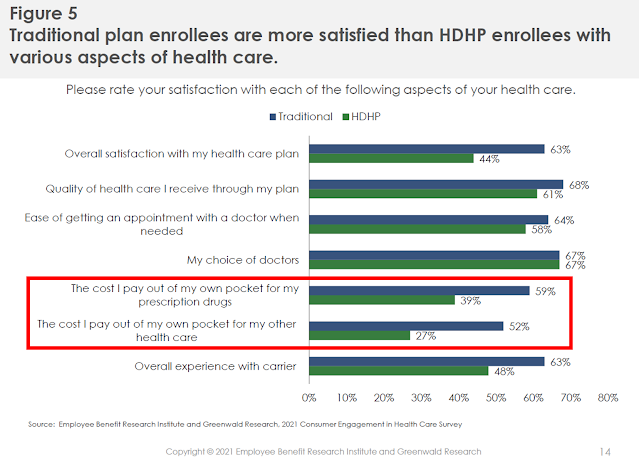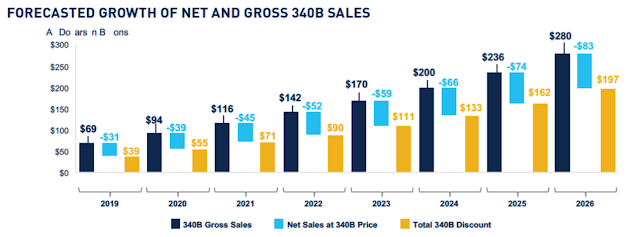- Offsides: A shocking update about the gross-to-net bubble for insulin
- Trick Play: OptumRx trolls us
- Fumble: High-deductible health plans foul out with patients
- Offensive Lines: The 340B program’s unstoppable growth
P.S. Please join the nearly 13,300 fans who run after me at @DrugChannels on Twitter. You can also chase me on LinkedIn, where I have more than 23,000 followers. I kick off every day with links to neat stuff for you and no coin flips.
Analysis of Insulin Competition and Costs in the United States, Milliman
Insulin continues to illustrate the warped incentives baked into the U.S. drug channel.
This new Milliman analysis examines how payers’ gross-to-net bubble for insulin inflated from 2007 to 2021. The depressing results are illustrated in the report’s Figure 3 (reproduced below). For the first quarter of 2021:
This new Milliman analysis examines how payers’ gross-to-net bubble for insulin inflated from 2007 to 2021. The depressing results are illustrated in the report’s Figure 3 (reproduced below). For the first quarter of 2021:
- Net cost of insulin = $88 per month
- Total value of rebates and discounts = $448 per month
[Click to Enlarge]
Look ahead: Forecasting drug spend and trend drivers, OptumRx
OptumRx has released an interesting set of on-demand videos.
Notice anything funny about the slide below? About how it purports to show the "OptumRx Commercial Trend," i.e., the change in drug spending at the PBM’s plan sponsor clients?
How about this: No y-axis!
Is the scale 0% to 10%? 0% to 100%?
Seriously, who does this? Are they trolling us?
For more on the disappointing state of PBMs’ trend reports, see my comments in PBMs and Drug Spending in 2020: Data from CVS Health (sort of), Express Scripts, Navitus, and WellDyne (Plus: The Demise of PBM Reporting).
Notice anything funny about the slide below? About how it purports to show the "OptumRx Commercial Trend," i.e., the change in drug spending at the PBM’s plan sponsor clients?
[Click to Enlarge]
How about this: No y-axis!
Is the scale 0% to 10%? 0% to 100%?
Seriously, who does this? Are they trolling us?
For more on the disappointing state of PBMs’ trend reports, see my comments in PBMs and Drug Spending in 2020: Data from CVS Health (sort of), Express Scripts, Navitus, and WellDyne (Plus: The Demise of PBM Reporting).
2021 Consumer Engagement in Health Care Survey, EBRI
Store this report in your “Unsurprised” file: People do not like paying out-of-pocket for #healthcare.
The Employee Benefit Research Institute (EBRI) asked more than 2,000 people for their thoughts on health insurance.
As you can see below, for high-deductible health plans (HDHPs) garnered less satisfaction than traditional plans. The largest gap in satisfaction was for prescriptions drugs. Perhaps that’s because patients with HDHPs pay out-of-pocket on the drug’s list price—even when plans get rebates and discounts.
One bright spot: For 2021, enrollment in high-deductible plans declined slightly, as I note in Employer Pharmacy Benefits 2021: Patient Specialty Costs Rise with Coinsurance and Accumulators.
ICYMI, some of my astute LinkedIn followers highlighted some shortcomings of the EBRI survey.
The Employee Benefit Research Institute (EBRI) asked more than 2,000 people for their thoughts on health insurance.
As you can see below, for high-deductible health plans (HDHPs) garnered less satisfaction than traditional plans. The largest gap in satisfaction was for prescriptions drugs. Perhaps that’s because patients with HDHPs pay out-of-pocket on the drug’s list price—even when plans get rebates and discounts.
[Click to Enlarge]
One bright spot: For 2021, enrollment in high-deductible plans declined slightly, as I note in Employer Pharmacy Benefits 2021: Patient Specialty Costs Rise with Coinsurance and Accumulators.
ICYMI, some of my astute LinkedIn followers highlighted some shortcomings of the EBRI survey.
340B Program at a Glance, BRG
Thanks to my Freedom of Information Act request, we now know that discounted purchases under the 340B Drug Pricing Program reached at least $38 billion in 2020. That figure is an astonishing 27% higher than its 2019 counterpart—and more than quadruple the value of discounted purchases in 2014.
Get ready: BRG projects that the 340B program will soon rank as the largest government program for prescription drugs. By 2026, the program’s purchases will exceed gross drug purchases of Medicaid and Medicare.
I remain mystified that a program of this scale still lacks a comprehensive regulatory infrastructure and operates primarily under increasingly controversial subregulatory guidance.
Get ready: BRG projects that the 340B program will soon rank as the largest government program for prescription drugs. By 2026, the program’s purchases will exceed gross drug purchases of Medicaid and Medicare.
[Click to Enlarge]
(Note: Typo in legend appears in original report.)
I remain mystified that a program of this scale still lacks a comprehensive regulatory infrastructure and operates primarily under increasingly controversial subregulatory guidance.
CDC Announces Plan To Send Every U.S. Household Pamphlet On Probabilistic Thinking, The Onion
The Onion, the world’s leading news publication, delivers a must-read blend of satire and statistics. From the article: “Walensky added that if Americans took away one easy lesson from the pamphlet, she hoped it would be P(H|E) = (P(E|H) *P(H))/P(E).”
Like me, you may ponder: Why not?
Like me, you may ponder: Why not?






No comments:
Post a Comment